Not too long ago, the role of a full-back was probably seen as one of the least important in football. They were tasked with defending opposition wingers and not much else. This perception of the role was well known in the world of football. As Jamie Carragher famously said, no one wants to grow up and be a Gary Neville. The Manchester United full-back had a very successful career, but Carragher was probably right. However, more recently players like Liverpool’s Trent Alexander-Arnold have changed the role of a full-back. Despite being a defender, he has shown he is one of the biggest attacking threats in the Premier League.
The role of a full-back has constantly been evolving in the last few years. They are now seen as one of the most integral parts to some of Europe’s biggest teams. However, their importance is not just limited to Europe. In my time covering Liga MX, it has become apparent how important they are to a number of teams in Mexico. Liga MX is extremely fast-paced and almost mimics as a basketball game with its end to end action. Therefore, the role of a full-back is completely rounded requiring high attacking output, as well as a solid defensive base.
This data analysis will use statistics to find the best full-backs Liga MX has to offer. The analysis will use data from the 2019/20 season, in which all players must have played at least 10 games. The data analysis will focus on a number of attacking and defensive metrics.
Progressive runs and passes
The first part of this data analysis will focus on each players ability to progress their team forward, either through passing or carrying the ball.
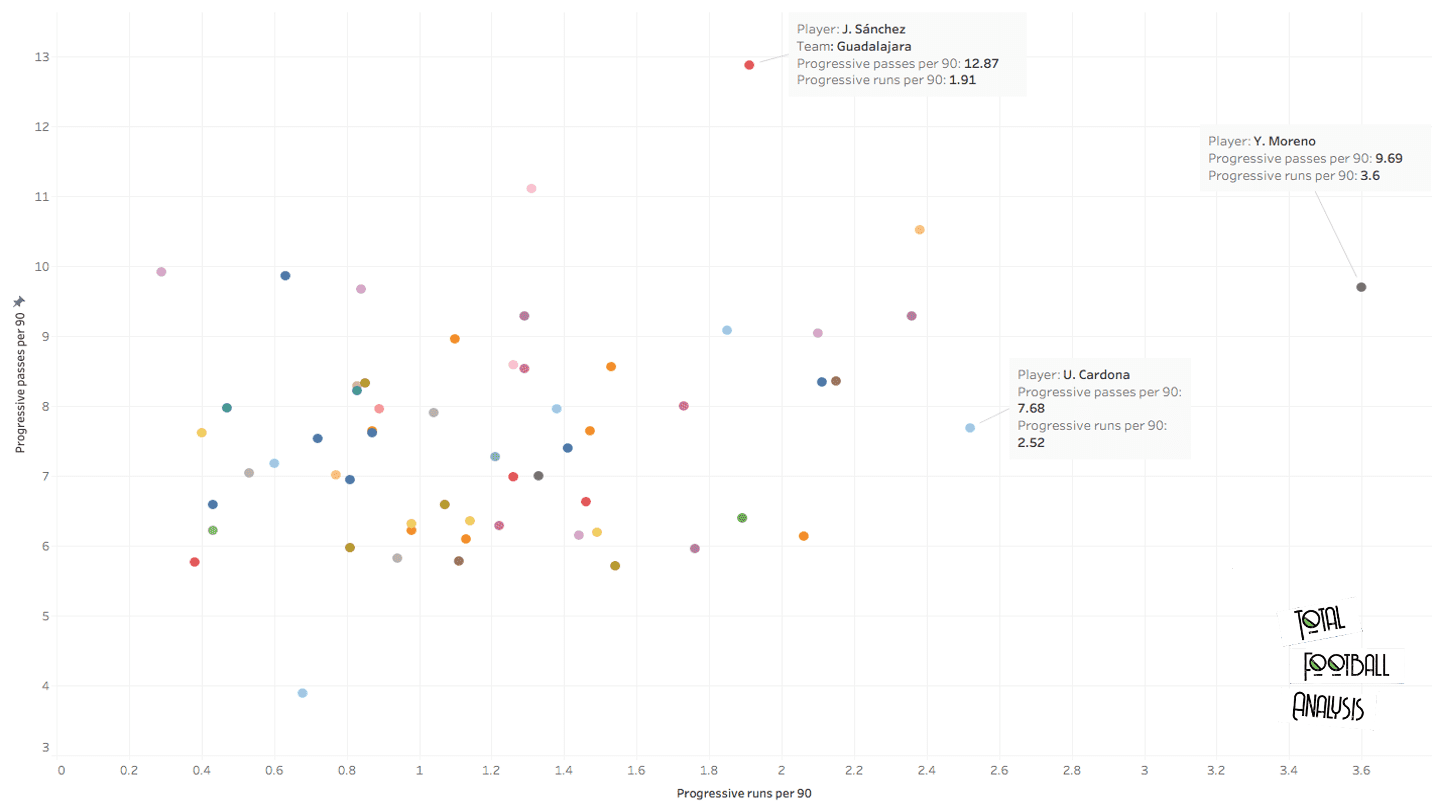
The data above shows some real stand out players. Players towards the top right corner show us individuals who attempt a high number of progressive runs and passes. One player who certainly ticks both boxes is Colombian, Yairo Moreno. The 25-year old helped Club Leon to a second-place finish in 19/20 Clausura. In that season he attempted one of the highest numbers of progressive passes, with 9.69 per 90. The data also shows he attempted the most progressive runs with 3.6 per 90.
This number of progressive runs is rarely matched, as the second most were achieved by Ulises Cardona. The Mexican primarily operates as a winger but did play a majority of games at full-back early in the season. In this season, he completed 2.52 progressive runs per 90. This was accompanied by a good number of progressive passes with 7.68 per 90, slightly less than Moreno.
At the other end of the spectrum, we have Jesús Sánchez of Chivas Guadalajara. The 31-year old attempted the most progressive passes with 12.87 per 90. The Mexican completed a respectable 1.91 progressive runs per 90. As Sánchez reach’s the latter stages of his career, it appears he opts to find passing solutions instead of carrying the ball forward.
There are also noticeable mentions for Jairo González, Necaxa, who completed 11.1 progressive passes and 1.31 progressive runs per 90. Joseph Abella, of Atlas, has similar statistics as he completed 10.52 progressive passes per 90. The Mexican also attempted a high number of progressive runs with 2.38 per 90.
Chance creation
With Liga MX’s attacking nature, balls into the box are key. This section of the data analysis will use statistics from crossing and deep completions.
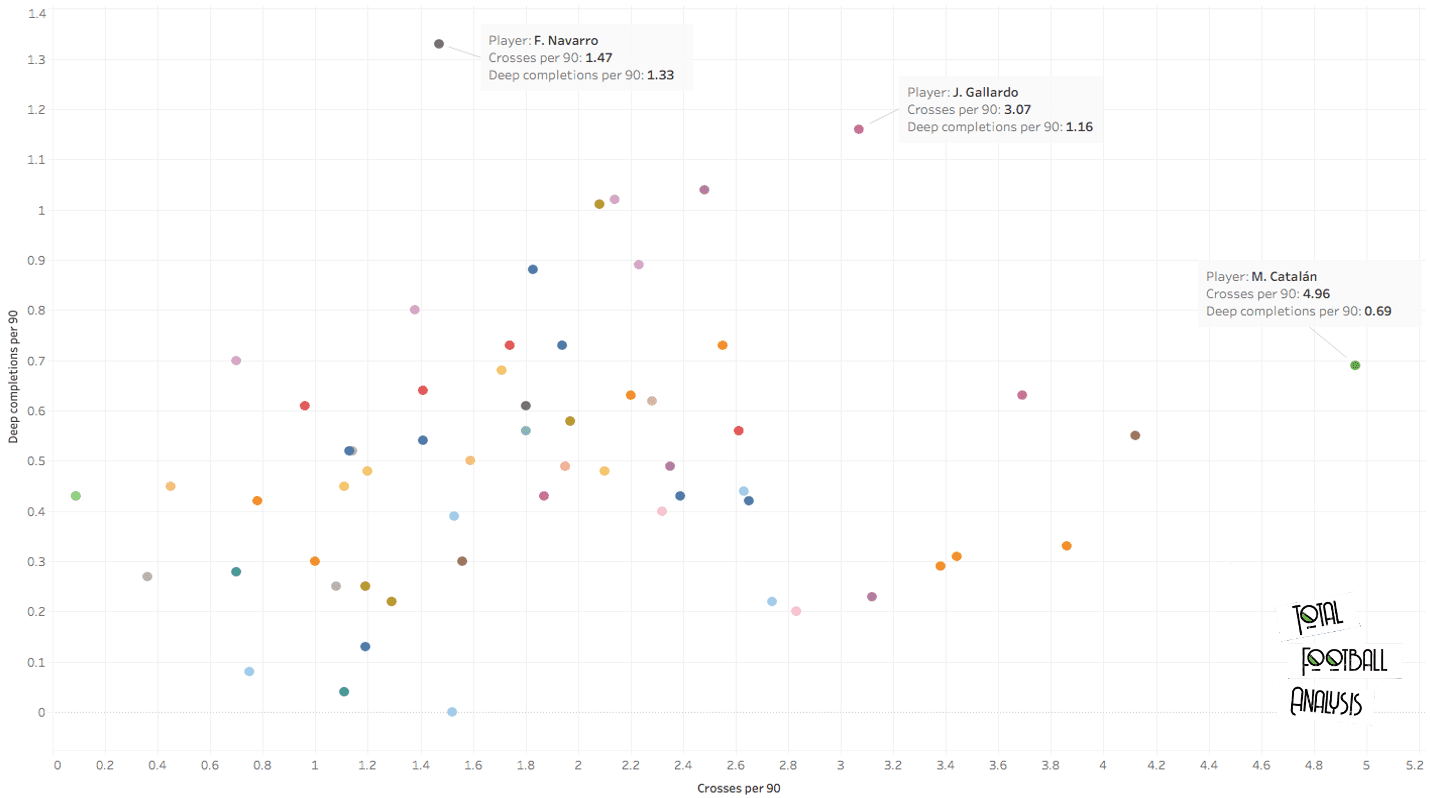
Matías Catalán attempted the highest number of crosses last season with 4.96 per 90. He also attempted a relatively high number of deep completions with 0.69 per 90. The only other play to attempt over four crosses a game was Alan Mozo, with 4.12 per 90. However, Mozo attempted slightly fewer deep completions with 0.55 per 90.
Luis Reyes is another player close to the four crosses per 90 mark with 3.86. Again, Reyes also attempts fewer deep completions with 0.33 per 90. Former Premier League man, Miguel Layún, has similar statistics as he attempts 3.69 crosses and 0.63 deep completions per 90.
Deep completions are a very important aspect for full-backs, as it means their attempted pass has put the team closer to the opposition goal. Fernando Navarro, of Club Leon, had the most deep completions with a staggering 1.33 per 90. The Mexican attempted a relatively low number of crosses, however, with 1.47 per 90.
Jesús Gallardo is another player who had a high number of deep completions, with 1.16 per 90. Gallardo also attempted a high number of crosses per 90, with 3.07. Suggesting his attacking output is a key part of his game.
Interestingly, none of the players highlighted in the progressive runs and passes section stand out here. One would presume, a player who carries his team forward would have a high number of crosses or deep completions. However, this may highlight that the above players have difficulty with their end product.
Attacking output
Whilst the above sections have used data to look at chance creation, this section will use statistics to evaluate the actual attacking output. The data analysis will use xA and actual assists. xA is used to look at the quality of passes a player makes and the likelihood of it resulting in a primary assist.
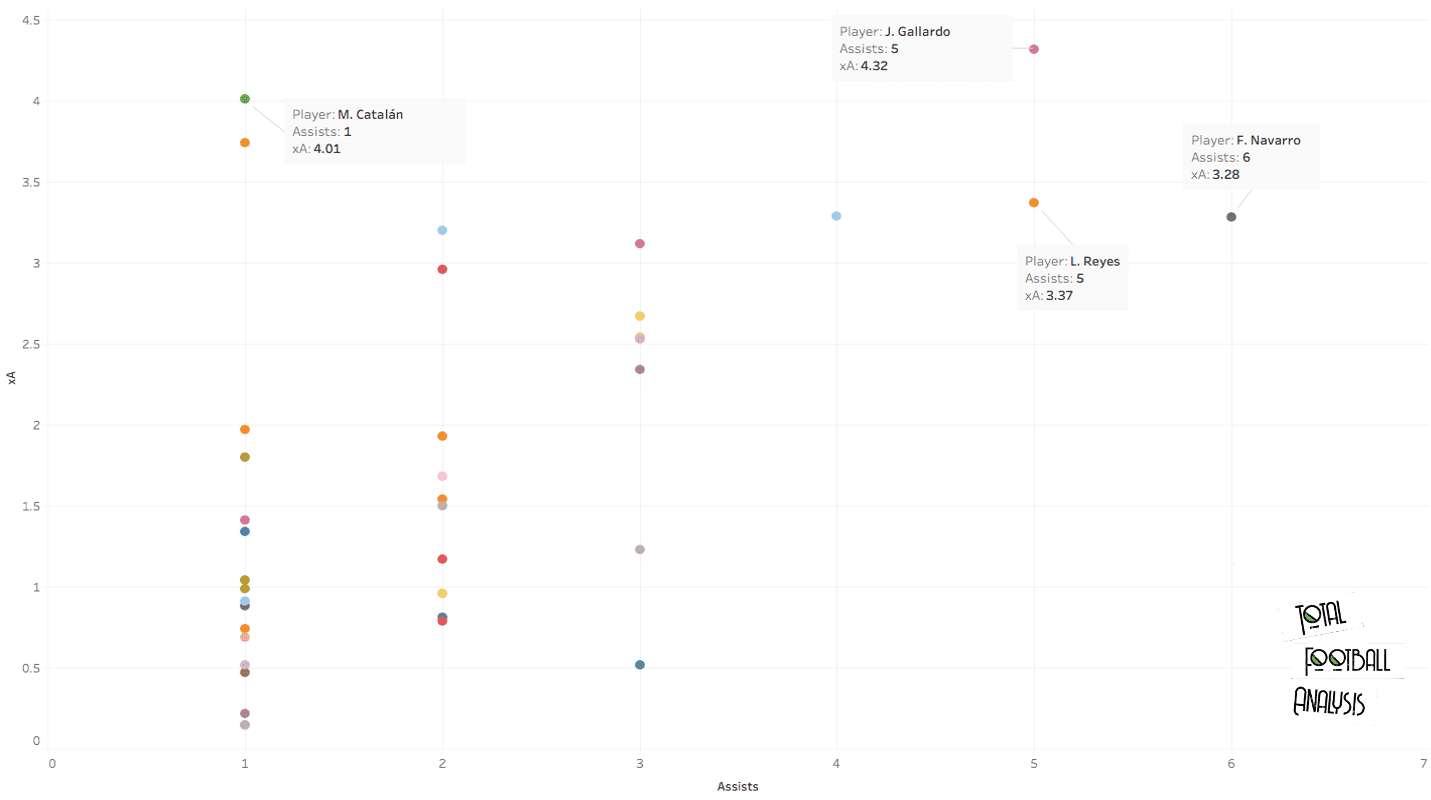
A high xA value would suggest that a player completed a high number of, or high-quality passes that could lead to an assist. In the analysis, several players exceed their xA value.
Firstly, we have Fernando Navarro who amassed 6 assists with only an xA of 3.28. This was the highest number of assists for a full-back in Liga MX. Close behind we have Luis Reyes, who had 5 assists from an xA of 3.37. Reyes was tied on number of assists with Jesús Gallardo, who also achieved 5 assists. Gallardo did have a slightly higher xA of 4.32.
Whilst, overperforming is, of course, a positive, we also need to understand why these players overachieve. All of the players mentioned above, play for high-quality teams, who possess high-quality strikers. By having these clinical strikers, it makes it much easier for these full-backs to overperform in terms of xA. Fernando Navarro is a useful example, as he achieved 6 assists from an xA of 3.28. Due to the high-class finishing from his teammates, it allowed Navarro to achieve more assist than expected.
If we were to flip this on its head, we have two players who can feel slightly hard done by. Firstly, we have Matías Catalán who only had 1 assist to his name. However, from the passes the Argentine made, he could have expected to have 4.01 assists. We also have Alonso Escoboza, from Club America. Escoboza also only had 1 assist, even though he had an xA of 3.74.
Escoboza poses an interesting topic. He and Luis Reyes both played for Club America. Reyes surpassed his xA by 1.63, however, Escoboza had 2.74 fewer assists than expected. Both players were playing in the same team with the same strikers. In this instance, we would suggest that Escoboza was extremely unlucky and his strikers did not help him out.
Defensive duels
So far, the data analysis has primarily focused on attacking metrics, as Liga MX places a large emphasis on this. However, a full-back still needs to be able to defend, therefore, this section will use data to analyse each player’s defensive output.
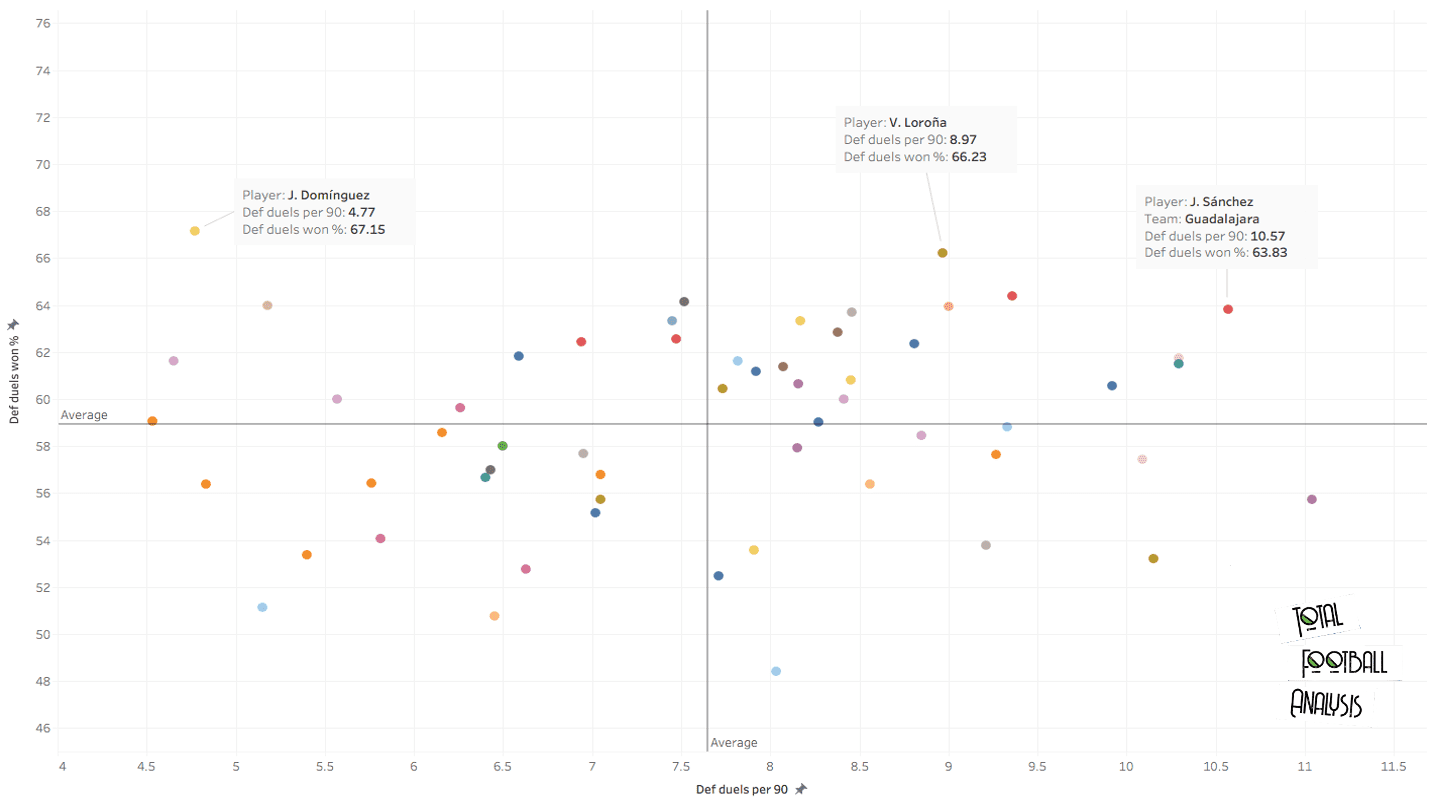
This first part has used statistics to analyse the number of defensive duels and the % won. In this chart, we are looking for players in the top two segments, who win a high % of duels.
Firstly, we have Julio Domínguez who won the highest % of defensive duels with 67.15%. However, the Mexican only engaged in a low number of duels, with 4.77 per 90.
As we move to the top right segment, we see players who engage in more defensive duels than the average and also win more than the average. Vladimir Loroña has the highest win % here, with 66.23%. The 21-year old also engaged in a high number of duels with 8.97 per 90.
Jesús Sánchez highlighted earlier also fairs well here with 10.57 defensive duels per 90. He also achieves a very good win % of 63.83%.
A very interesting aspect here is that very few of the players mentioned earlier, in the attacking sections, appear in the defensive duel’s analysis. Many of the attacking full-backs win less than the average % of defensive duels, which sits at 58.94%. This may be expected as those who attack a lot more are less likely to be defensive-minded.
Defensive actions
However, defensive duels are limited to ground duels and winning the ball off the opposition. Defending is not purely 1v1 tackles. Interceptions, blocks and clearances are much more likely to be part of a full-backs game. This final part of the data analysis will consider the number of successful defensive actions.
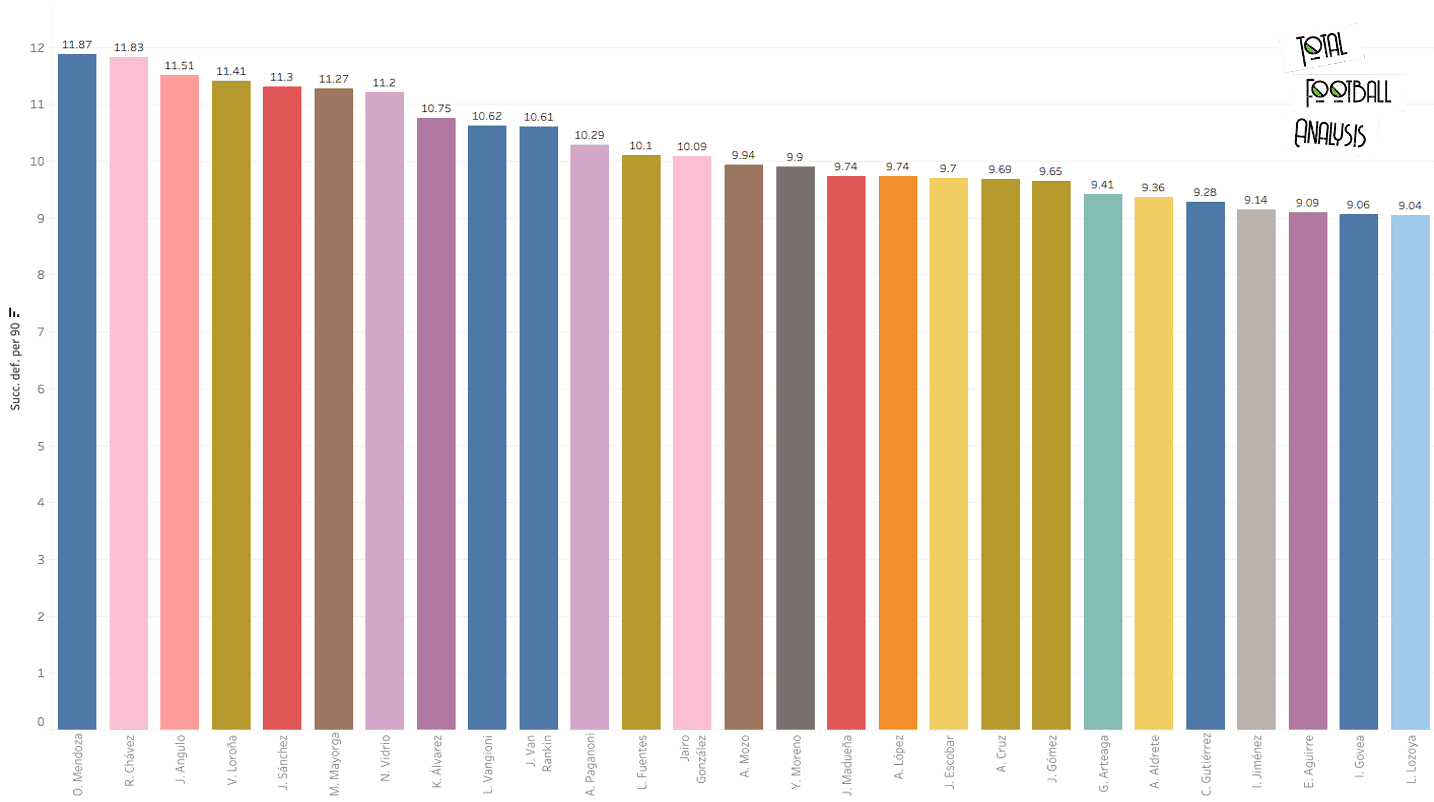
This data has only included players who have more successful defensive actions, than the league average which sits at 8.91 per 90.
Interestingly, we still don’t see a number of players highlighted earlier in the analysis. However, it does provide a more rounded approach to defensive output.
Omar Mendoza, previously of Club Tijuana, had the highest successful defensive actions with 11.87 per 90. Ricardo Chávez is very close behind with 11.83 per 90. Players highlighted earlier, such as Vladimir Loroña and Jesús Sánchez also stand out here with 11.41 and 11.3 defensive actions per 90, respectively.
Shortlisted players
The data analysis so far has looked at a number of statistics in attacking and defensive phases. The table below has shortlisted several of the players mentioned in the analysis, to provide a holistic view of their attacking and defensive output, compared to their counterparts. Each player is ranked from 1-6.

The above analysis shows us the variation in all the full-backs we have analysed. No player completely stands out in each area, which is fairly unsurprising. Below we will highlight three players who show varying abilities.
Jesús Gallardo – Gallardo stood out very well in the number of attacking metrics. The Mexican finished the season with 5 assists from an xA of 4.23. These impressive statistics would be a result of Gallardo’s attacking style. Out of the players shortlisted he ranks well in crosses and progressive runs/passes. Gallardo is also very accomplished with deep completions as he completed an impressive 1.16 per 90. The 26-year olds defensive capabilities may come into question, as he had the lowest defensive duels success, with 52.75%.
Jesús Sánchez – Sánchez was highlighted several times throughout this data analysis. Possibly the most rounded full-back, as he ranks well across several metrics. He leads the way with progressive runs and passes, showing he has great ability to carry his team up the pitch. The 30-year old had a low attacking output with only 2 assists from an xA of 0.79. This combined with his low number of crosses (1.74) and deep completions (0.73), suggests the final ball is not Sánchez’s strong point. However, the Mexican has the highest number of defensive duels with 10.57 per 90, winning 63.83% of those.
Vladimir Loroña – The 21-year old was barely mentioned in the early parts of the data analysis, due to his low attacking output. Loroña had the fewest assists with 1 all season. The Mexican also attempted very few crosses with 2.08 per 90. Loroña did boast an impressive number of deep completions with 1.01 per 90. However, defensively is where Loroña really shines. Out of the shortlisted players, he had the highest defensive duel win % with 66.23% and the most successful defensive actions with 11.41 per 90.
Conclusion
This data analysis aimed to use statistics to see the type and the best full-backs Liga MX. The data suggests that attacking output is a key part of full-backs in Liga MX, and Jesús Gallardo is one who embraces this. Liga MX veteran Jesús Sánchez showed he is still more than capable, highlighting himself as one of the most rounded full-backs in the league. On the other hand, we have up and coming players like Vladimir Loroña who show that defending is not a dying art for full-backs.





Comments